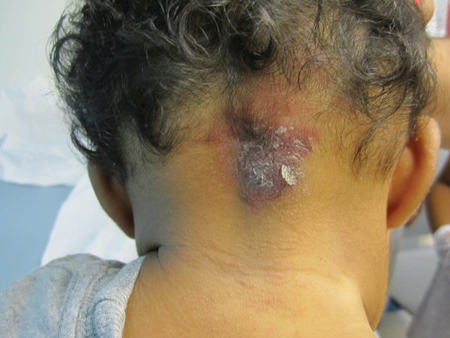An infant with a persistent scaling eruption on nape of neck
A 4-month-old female presents to your clinic with a persistent, erythematous, scaling eruption involving the posterior neck. Her mother reports the eruption began 1 month after birth. The area seems pruritic, and she keeps socks on her daughter’s hands to prevent her from scratching. She had no improvement with over-the-counter antifungal cream or hydrocortisone 1% cream applied twice daily for 2 weeks each. She has not developed rashes elsewhere.

Marissa Perman
On physical exam, involving the nape of the neck is a 2-cm, well-defined, round, crusted and focally eroded, erythematous plaque. On further inspection, you note a bright red vascular patch underlying and extending beyond the scaling plaque that is consistent with a nevus simplex (also known as a “stork bite” or “salmon patch”). She has similar vascular stains present since birth over both eyelids and glabella (“angel kisses” or “salmon patches”).
What is the most likely etiology?
Diagnosis: Localized eczema overlying a nevus simplex (Meyerson phenomenon)
A localized eczematous reaction involving a birthmark is not an uncommon finding in children, although it is infrequently described in the literature. The most common description of eczema overlying a birthmark is usually in association with a melanocytic nevus, often congenital melanocytic nevi in children. This is referred to as the Meyerson phenomenon, after Meyerson first described this finding in two patients with acquired nevi in 1971. A similar phenomenon also occurs in many other pre-existing lesions, particularly vascular lesions, such as a nevus simplex, as described in the case above.

Figure 1. A 4-month-old female with a pruritic, scaling eruption involving the nape of the neck.
Source: Perman MJ
In general, the Meyerson phenomenon has been described more often in males with nevi on the trunk and proximal extremities. Patients may be asymptomatic or occasionally pruritic. A background of atopic dermatitis is variable, and a prior history is often not elucidated.
With melanocytic nevi, the eczema often surrounds the lesion, which may be referred to as halo dermatitis or halo eczema. Eczema surrounding or overlying the primary skin finding can occur at any time, from infancy to adulthood. The pathophysiology is not well understood but may be due to collision of two conditions or a trigger from the underlying lesion leading to inflammatory changes at that site.
Besides congenital and acquired melanocytic nevi and vascular lesions, the Meyerson phenomenon has been reported with seborrheic keratoses, dermatofibromas, lentigos, keloids, insect bites, and basal and squamous cell carcinomas.
Histopathologically, signs of the primary lesion (nevus cells in melanocytic nevi or vascular ectasia in the case of nevus simplex or port-wine stains) are present, along with acute eczematous changes, such as a superficial dermal lymphocytic infiltrate and spongiosis with eosinophils in the epidermis.
The Meyerson phenomenon can persist as long as a few months to several years. In many cases, it is responsive to mid-potency topical steroids or topical calcineurin inhibitors. Treatment of the primary lesion also may clear the eczema; for example, laser therapy for vascular lesions or excision of melanocytic nevi. After topical therapy, the primary lesion usually remains the same and does not regress. However, there are reports of some congenital melanocytic nevi developing hypopigmentation for several years after the eczematous eruption.
Vascular stains in the nuchal region may often go unnoticed during the newborn period, especially if they are covered by hair. It is important to be aware of the Meyerson phenomenon in pre-existing lesions, such as nevus simplex, in order to provide symptomatic and appropriate therapy if needed. Asymptomatic melanocytic nevi or vascular stains with the Meyerson phenomenon may not require treatment, as topical therapy will not change the outcome, nor does the eczema suggest a worse prognosis of the primary condition.
For more information:
- Bonifazi E. J Am Acad Dermatol. 1998;38:130.
- Fonder MA. Pediatr Dermatol. 2007;24:376-379.
- Hofer T. Dermatology. 2002;205:180-183.
- Loh J. J Cutan Med Surg. 2010;14:30-32.
- Rolland S. Pediatr Dermatol. 2009;26:292-297.
- Tay YK. J Am Acad Dermatol. 1996;35:811-813.



